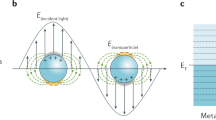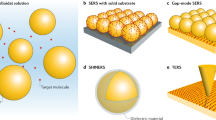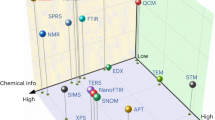Abstract
Surface-enhanced Raman scattering (SERS) is a powerful spectroscopy technique that can provide non-destructive and ultra-sensitive characterization down to single molecular level, comparable to single-molecule fluorescence spectroscopy1,2,3,4,5,6,7,8,9,10,11,12,13,14,15. However, generally substrates based on metals such as Ag, Au and Cu, either with roughened surfaces or in the form of nanoparticles, are required to realise a substantial SERS effect, and this has severely limited the breadth of practical applications of SERS. A number of approaches have extended the technique to non-traditional substrates14,16,17, most notably tip-enhanced Raman spectroscopy (TERS)18,19,20 where the probed substance (molecule or material surface) can be on a generic substrate and where a nanoscale gold tip above the substrate acts as the Raman signal amplifier. The drawback is that the total Raman scattering signal from the tip area is rather weak, thus limiting TERS studies to molecules with large Raman cross-sections. Here, we report an approach, which we name shell-isolated nanoparticle-enhanced Raman spectroscopy, in which the Raman signal amplification is provided by gold nanoparticles with an ultrathin silica or alumina shell. A monolayer of such nanoparticles is spread as ‘smart dust’ over the surface that is to be probed. The ultrathin coating keeps the nanoparticles from agglomerating, separates them from direct contact with the probed material and allows the nanoparticles to conform to different contours of substrates. High-quality Raman spectra were obtained on various molecules adsorbed at Pt and Au single-crystal surfaces and from Si surfaces with hydrogen monolayers. These measurements and our studies on yeast cells and citrus fruits with pesticide residues illustrate that our method significantly expands the flexibility of SERS for useful applications in the materials and life sciences, as well as for the inspection of food safety, drugs, explosives and environment pollutants.
This is a preview of subscription content, access via your institution
Access options
Subscribe to this journal
Receive 51 print issues and online access
$199.00 per year
only $3.90 per issue
Buy this article
- Purchase on Springer Link
- Instant access to full article PDF
Prices may be subject to local taxes which are calculated during checkout




Similar content being viewed by others
References
Nie, S. M. & Emory, S. R. Probing single molecules and single nanoparticles by surface enhanced Raman scattering. Science 275, 1102–1106 (1997)
Kneipp, K. et al. Single molecule detection using surface-enhanced Raman scattering (SERS). Phys. Rev. Lett. 78, 1667–1670 (1997)
Moskovits, M. Surface-enhanced spectroscopy. Rev. Mod. Phys. 57, 783–826 (1985)
Kneipp, K., Moskovits, M. & Kneipp, H. eds. Surface-enhanced Raman Scattering–Physics and Applications (Springer, 2006)
Camden, J. P., Dieringer, J. A. & Van Duyne, R. P. Controlled plasmonic nanostructures for surface-enhanced spectroscopy and sensing. Acc. Chem. Res. 41, 1653–1661 (2008)
Baumberg, J. J. et al. Angle-resolved surface-enhanced Raman scattering on metallic nanostructured plasmonic crystals. Nano Lett. 5, 2262–2267 (2005)
Cao, Y. W. C., Jin, R. C. & Mirkin, C. A. Nanoparticles with Raman spectroscopic fingerprints for DNA and RNA detection. Science 279, 1536–1540 (2002)
Chen, Z. et al. Protein microarrays with carbon nanotubes as multicolor Raman labels. Nature Biotechnol. 26, 1285–1292 (2008)
Jain, P. K., Huang, X., El-Sayed, I. H. & El-Sayed, M. A. Noble metals on the nanoscale: optical and photothermal properties and some applications in imaging, sensing, biology, and medicine. Acc. Chem. Res. 41, 1578–1586 (2008)
Jackson, J. B. & Halas, N. J. Surface-enhanced Raman scattering on tunable plasmonic nanoparticle substrates. Proc. Natl Acad. Sci. USA 101, 17930–17935 (2004)
Graham, D., Thompson, D. G., Smith, W. E. & Faulds, K. Control of enhanced Raman scattering using a DNA-based assembly process of dye-coded nanoparticles. Nature Nanotechnol. 3, 548–551 (2008)
Qian, X. et al. In vivo tumor targeting and spectroscopic detection with surface-enhanced Raman nanoparticle tags. Nature Nanotechnol. 26, 83–90 (2008)
Anker, J. N. et al. Biosensing with plasmonic nanosensors. Nature Mater. 7, 442–453 (2008)
Tian, Z. Q., Ren, B., Li, J. F. & Yang, Z. L. Expanding generality of surface-enhanced Raman spectroscopy with borrowing SERS activity strategy. Chem. Commun. 34, 3514–3534 (2007)
Nie, S. M. & Zare, R. N. Optical detection of single molecules. Annu. Rev. Biophys. Biomed. 26, 567–596 (1997)
Park, S., Yang, P., Corredor, P. & Weaver, M. J. Transition metal-coated nanoparticle films: vibrational characterization with surface-enhanced Raman scattering. J. Am. Chem. Soc. 124, 2428–2429 (2002)
Tian, Z. Q. & Ren, B. Adsorption and reaction at electrochemical interfaces as probed by surface-enhanced Raman spectroscopy. Annu. Rev. Phys. Chem. 55, 197–229 (2004)
Stöckle, R. M., Suh, Y. D., Deckert, V. & Zenobi, R. Nanoscale chemical analysis by tip-enhanced Raman spectroscopy. Chem. Phys. Lett. 318, 131–136 (2000)
Pettinger, B., Ren, B., Picardi, G., Schuster, R. & Ertl, G. Nanoscale probing of adsorbed species by tip-enhanced Raman spectroscopy. Phys. Rev. Lett. 92, 096101–096104 (2004)
Wu, D. Y., Li, J. F., Ren, B. & Tian, Z. Q. Electrochemical surface-enhanced Raman spectroscopy of nanostructures. Chem. Soc. Rev. 37, 1025–1041 (2008)
Frens, G. Controlled nucleation for regulation of particle-size in monodisperse gold suspension. Nature 241, 20–22 (1973)
Liz-Marzán, L. M., Michael, G. & Mulvaney, P. Synthesis of nanosized gold-silica core-shell particles. Langmuir 12, 4329–4335 (1996)
Lu, Y., Yin, Y., Li, Z. Y. & Xia, Y. Synthesis and self-assembly of Au@SiO2 core-shell colloids. Nano Lett. 2, 785–788 (2002)
Mulvaney, S. P., Musick, M. D., Keating, C. D. & Natan, M. J. Glass-coated, analyte-tagged nanoparticles: a new tagging system based on detection with surface-enhanced Raman scattering. Langmuir 19, 4784–4790 (2003)
Smith, W. E. Practical understanding and use of surface enhanced Raman scattering/surface enhanced resonance Raman scattering in chemical and biological analysis. Chem. Soc. Rev. 37, 955–964 (2008)
Sherry, L. J. et al. Localized surface plasmon resonance spectroscopy of single silver nanocubes. Nano Lett. 5, 2034–2038 (2005)
Ren, B. et al. In situ monitoring of Raman scattering and photoluminescence from silicon surfaces in HF aqueous solutions. Appl. Phys. Lett. 72, 933–935 (1998)
Sujith, A. et al. Surface enhanced Raman scattering analyses of individual silver nanoaggregates on living single yeast cell wall. Appl. Phys. Lett. 92, 103901 (2008)
Schulte, F., Mader, J., Kroh, L. W., Panne, U. & Kneipp, J. Characterization of pollen carotenoids with in situ and high-performance thin-layer chromatography supported resonant Raman spectroscopy. Anal. Chem. 81, 8426–8433 (2009)
Lee, D. et al. Quantitative analysis of methyl parathion pesticides in a polydimethylsiloxane microfluidic channel using confocal surface-enhanced Raman spectroscopy. Appl. Spectrosc. 60, 373–377 (2006)
Acknowledgements
We thank P. Bartlett for suggestions and editing of the English while writing the paper. We thank R. Zare, N. Zheng, B. Mao, U. K. Sur and L. Yang for discussions. We also thank Y. Yu, Y. Wu, M. Zhuang, X. Wang and A. Wang for assistance in experiments. This work was supported by MOST, China (2009CB930703, 2007DFC40440 and 2007CB935603), the NSF of China (20620130427 and 20533040), the BES DOE (DE-FG02-07ER46394) and the US NSF (DMS 0706436, CMMI 0403671).
Author Contributions Z.Q.T., Z.L.W., J.F.L. and B.R. conceived and designed the experiments, analysed the results and participated in writing the manuscript. J.F.L., Y.F.H., Y.D., S.B.L., X.S.Z., F.R.F., W.Z. and Z.Y.Z. performed the experiments and analysed the results. Z.L.Y. and D.Y.W contributed to theoretical calculations.
Author information
Authors and Affiliations
Corresponding authors
Ethics declarations
Competing interests
The authors declare no competing financial interests.
Supplementary information
Supplementary Information
This file contains Supplementary Information sections S1-S10 including Supplementary Figures S1-S14 with legends, and Supplementary References. (PDF 786 kb)
Rights and permissions
About this article
Cite this article
Li, J., Huang, Y., Ding, Y. et al. Shell-isolated nanoparticle-enhanced Raman spectroscopy. Nature 464, 392–395 (2010). https://doi.org/10.1038/nature08907
Received:
Accepted:
Issue Date:
DOI: https://doi.org/10.1038/nature08907
This article is cited by
-
Noise learning of instruments for high-contrast, high-resolution and fast hyperspectral microscopy and nanoscopy
Nature Communications (2024)
-
Nanocurvature-induced field effects enable control over the activity of single-atom electrocatalysts
Nature Communications (2024)
-
Untethered Micro/Nanorobots for Remote Sensing: Toward Intelligent Platform
Nano-Micro Letters (2024)
-
Progress and prospect of Pt-based catalysts for electrocatalytic hydrogen oxidation reactions
Nano Research (2024)
-
Local cation-tuned reversible single-molecule switch in electric double layer
Nature Communications (2023)
Comments
By submitting a comment you agree to abide by our Terms and Community Guidelines. If you find something abusive or that does not comply with our terms or guidelines please flag it as inappropriate.



